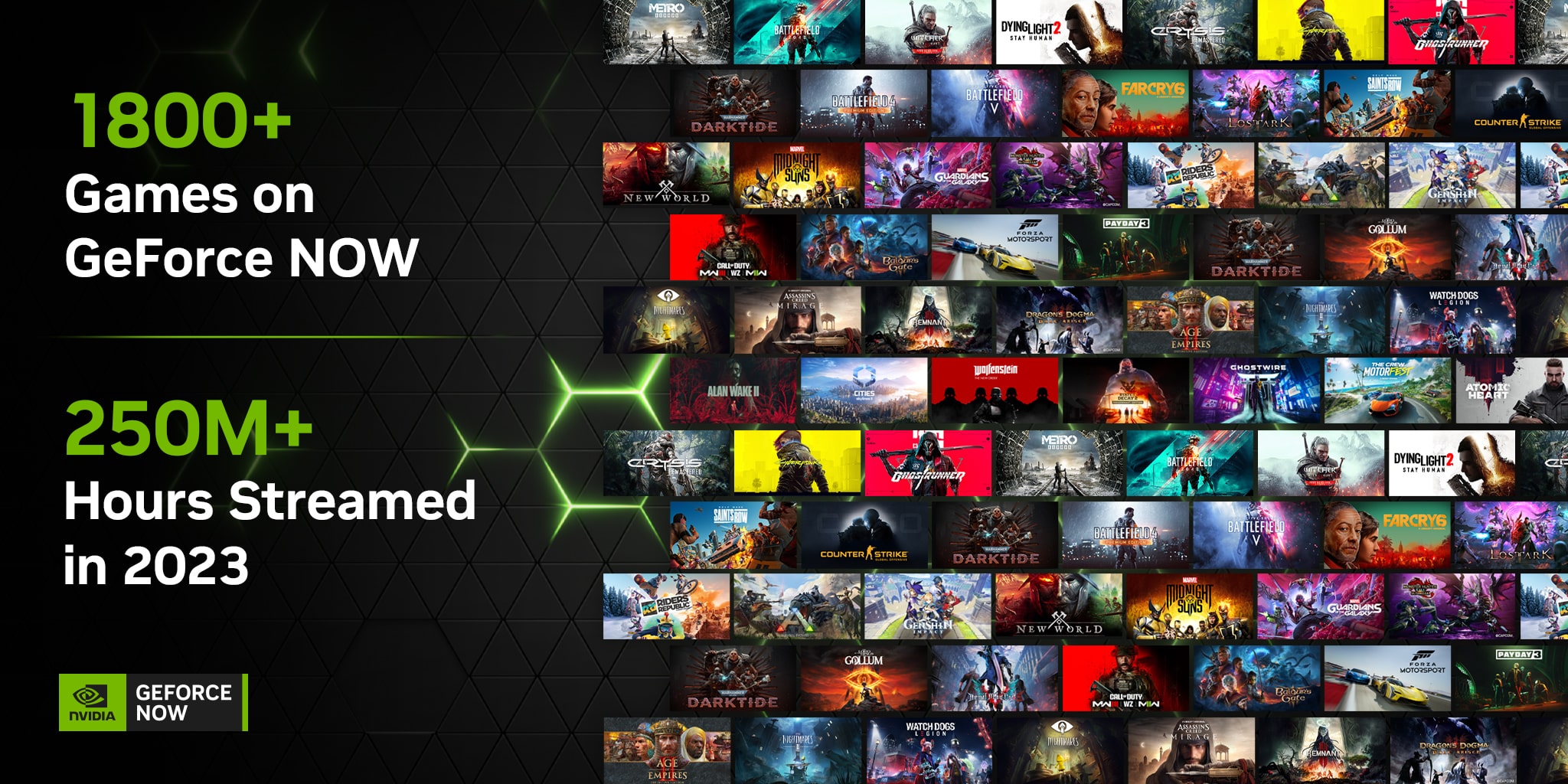
At the end of 2023, NVIDIA announced that their community had streamed “over 250” million hours of game play in 2023 using GeForce NOW – NVIDIA’s cloud gaming service that let’s you play PC games you own from Steam, Epic, Xbox and other digital stores on all of your devices via the cloud. That number is up over their first two years of service (which were measured February to February) when they streamed around 175 and 180 million hours of gameplay respectively.
250 Million Hours streamed sure sounds like a lot! But, the units make it a little tricky to fully grok. So, let’s try and break it down a little.
What is the Average Number of GFN Concurrent Players?
It is pretty straightforward to take the number of hours streamed over the year to get an average number of concurrent players.
250M Hours a Year / 365 Days = 680K Hours a Day / 24 Hours = 29K Concurrent Players on average.To put that in perspective, at any given time over the last 6 months, Steam alone averaged about 29 million online users and about 8 million players in game.
So, GeForce NOW represents (at best) 0.3% of Steam game play. Yep – at best it is less than one half of one percent. In reality, that GFN play time is actually split across the Epic (including Fortnite), Ubisoft Connect and Xbox stores as well. So, GFN likely represents an even smaller fraction of Steam usage than 0.3%.
What’s the takeaway here? Even cloud gaming’s most successful service, GeForce NOW, is still a tiny fraction of the gaming market. Cloud Gaming is still at best a “1%” market – maybe even more like a “0.1%” market.
How Much GFN Capacity is Deployed Around the World?
It’s interesting to take the numbers NVIDIA published and try to look at them from a few different angles.
Because of the free tier, we know that, for most of the time, GFN datacenters actually run with a queue. This means that GFN’s capacity is mostly always in use. But, if we throw in a factor of two for downtimes like the middle of the night/morning, we’d get this estimate:
GFN Capacity ~ Concurrent Users on Average x 2 = 29K x 2 ~ 58K serversTo put that in perspective. That number is about 1/1000 of the number of PlayStation 5 consoles sold to date since the console was first released in 2020.

How Many Paying Subscribers Does GeForce NOW have?
NVIDIA hasn’t been as forthcoming about this number as the hours of gameplay streamed. But, we can take a WAG based on that hours streamed number. Let’s start by breaking it down per week:
250M hours a year / 52 weeks ~ 5M hours streamed a week. Some of that play time is going to free-tier members. But, let’s ignore that for now and assume that all that time is coming from paid members. As a guess, let’s estimate that an average paying subscriber plays about 5 hours a week (Remember the mean/average is always higher than the median for a number like this). That would give us an estimate of around 1 million paying subscribers.
5M hours streamed a week / 5 hours per paying subscriber ~ 1M subscribersGiven the uncertainty around how much of the play time is actually from free-tier members and whether the average weekly playtime is 1 hour or 10 hours a week, the error bars are pretty big in this estimate. But, the number is probably somewhere between 500,000 and 4 million paying subscribers in a given month.
Conclusions
All of these numbers point to the same conclusion: Cloud Gaming (as represented here by what is likely its most successful service to date) still represents far less than 1% of the PC and Console gaming world.
The good news is that there is certainly plenty of room to grow!


Your article linked at the bottom, from February 2023, says they did 350 million in last year.
So some of your facts don’t add up.
Thanks for the comment Jeff! We also noticed that discrepancy. The 250M quoted for 2023 is pretty clear, though, and comes directly from NVIDIA’s blog (see the first link in the article – sorry for the broken link; the link has now been fixed).
The 350 million number for last year, on the other hand, was inferred based on a reported 700 million number (again directly from NVIDIA) in total for the service for all time. It *could* be that the 700M number included time when the service was in Beta all the way back to 2016. Which would mean attributing 350M to just year 3 (Feb. to Feb.) was ~50% high at that time. Or, perhaps there really was a drop between 2022 and 2023 (perhaps due to some territory changes).
Anyway, the difference between 180M (reported year 2 Feb-Feb), 350M (inferred for year 3 Feb-Feb) hours and 250M (reported for 2023) streamed a year doesn’t actually amount to a big difference in the conclusions. For example, it’s the difference between 0.1% to 0.2%.